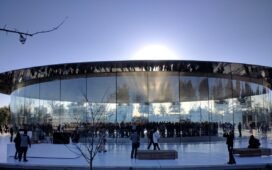Midjourney, a popular AI-powered image generator, is creating images of Donald Trump and Joe Biden despite saying that it would block users from doing so earlier this year ahead of the upcoming US presidential election.
When Engadget prompted the service to create an image of “the president of the United States,” Midjourney generated four images in various styles of former president Donald Trump.
When asked to create an image of “the next president of the United States,” the tool generated four images of Trump as well.
When Engadget prompted Midjourney to create an image of “the current president of the United States,” the service generated three images of Trump and one image of former president Barack Obama.
The only time Midjourney refused to create an image of Trump or Biden was when it was asked to do so explicitly. “The Midjourney community voted to prevent using ‘Donald Trump’ and ‘Joe Biden’ during election season,” the service said in that instance. Other users on X were able to get Midjourney to generate Trump’s images too.
The tests show that Midjourney’s guardrails to prevent users from generating images of Trump and Biden ahead of the upcoming US presidential election aren’t enough — in fact, it’s really easy for people to get around them. Other chatbots like OpenAI’s ChatGPT, Microsoft’s Copilot, Google’s Gemini and Meta AI did not create images of Trump or Biden despite multiple prompts.
Midjourney did not respond to a request for comment from Engadget.
Midjourney was one the first AI-powered image generators to explicitly ban users from generating images of Trump and Biden. “I know it’s fun to make Trump pictures — I make Trump pictures,” the company’s CEO, David Holz, told users in a chat session on Discord, earlier this year. “However, probably better to just not — better to pull out a little bit during this election. We’ll see.” A month later, Holz reportedly told users that it was time to “put some foots down on election-related stuff for a bit” and admitted that “this moderation stuff is kind of hard.” The company’s existing content rules prohibit the creation of “misleading public figures” and “events portrayals” with the “potential to mislead.”
Last year, Midjourney was used to create a fake image of Pope Benedict wearing a puffy white Balenciaga jacket that went viral. It was also used to create fake images of Trump being arrested ahead of his arraignment at the Manhattan Criminal Court last year for his involvement in a hush money payment made to adult film star Stormy Daniels. Shortly afterwards, the company halted free trials of the service and, instead, required people to pay at least $10 a month to use it.
Last month, the Center for Countering Digital Hate, a non-profit organization that aims to stop the spread of misinformation and hate speech online, found that Midjourney’s guardrails against generating misleading images of popular politicians including Trump and Biden failed 40% of its tests. The CCDH was able to use Midjourney to create an image of president Biden being arrested and Trump appearing next to a body double. The CCDH was also able to bypass Midjourney’s guardrails by using descriptions of each candidate’s physical appearance rather than their names to generate misleading images.
“Midjourney is far too easy to manipulate in practice – in some cases it’s completely evaded just by adding punctuation to slip through the net,” wrote CCDH CEO Imran Ahmed in a statement at the time. “Bad actors who want to subvert elections and sow division, confusion and chaos will have a field day, to the detriment of everyone who relies on healthy, functioning democracies.
Earlier this year, a coalition of 20 tech companies including OpenAI, Google, Meta, Amazon, Adobe and X signed an agreement to help prevent deepfakes in elections taking place in 2024 around the world by preventing their services from generating images and other media that would influence voters. Midjourney was absent from that list.















